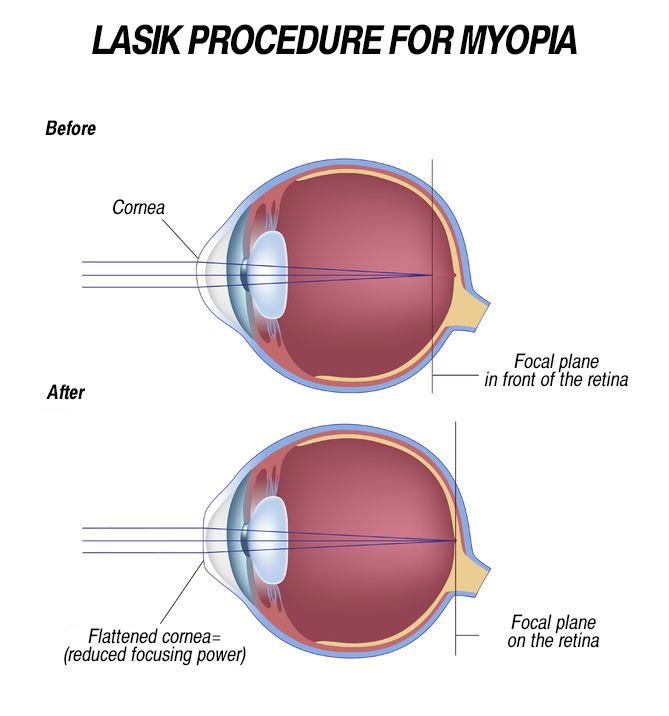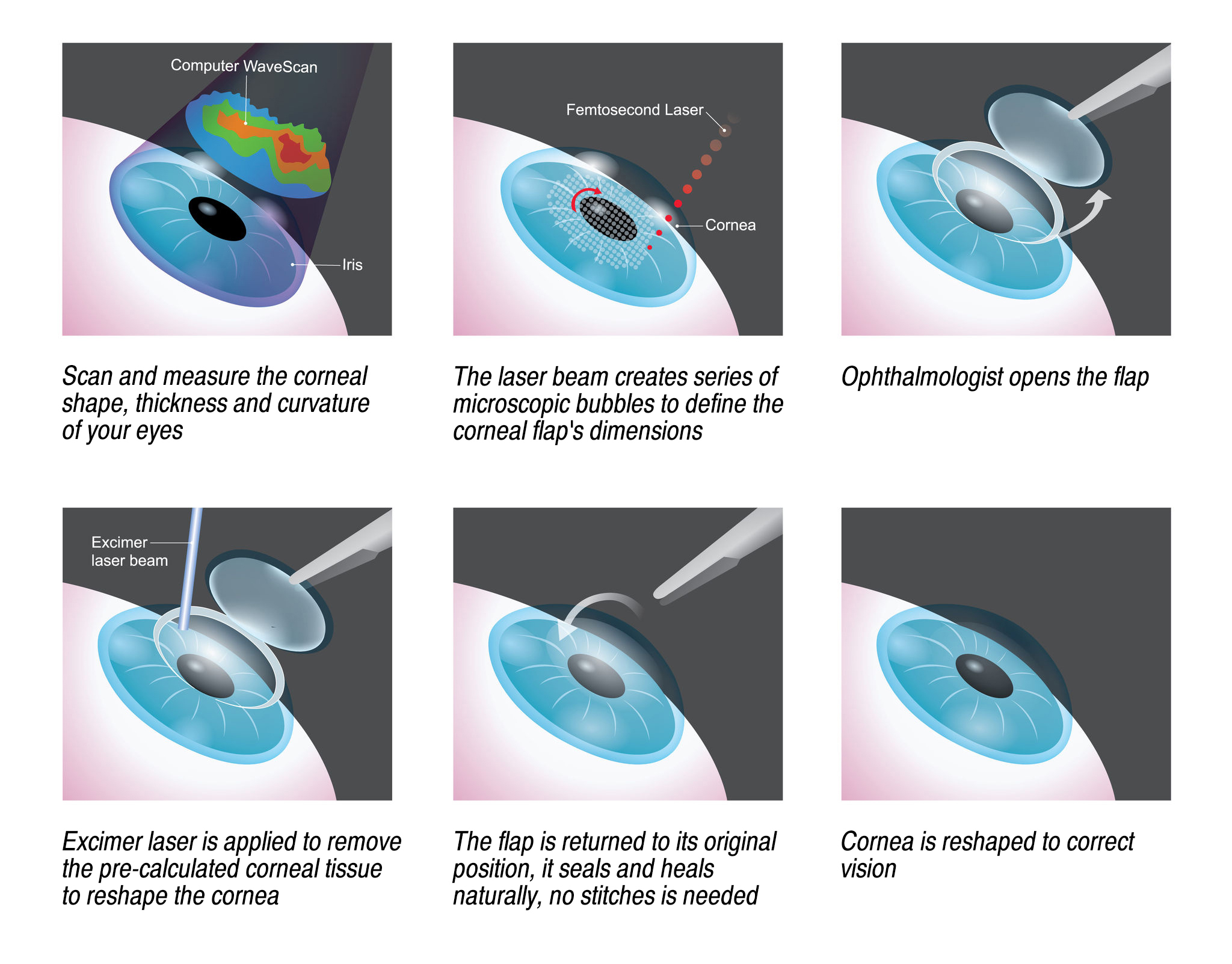1. What is LASIK
LASIK procedure corrects myopia, hyperopia and astigmatism. It involves two major steps: cutting flap and reshaping curvature. First, cut a corneal flap using either microkeratome or femtosecond laser. Second, with the flap prepared, apply excimer laser in the middle layer to remove the pre-calculated corneal tissue to correct vision and reshape the cornea.
- Correct Up to -15.00D of Myopia, up to +6.00D of Hyperopia, and up to -6.00D of Astigmatism
- Myopia(short-sightedness): Cornea is re-shaped to flatten up a little bit
- Hyperopia (far-sightedness): makes the cornea more protruding
- Astigmatism: to ablate specific axis

2. Am I a Suitable Candidate for LASIK
- At least 18 years old
- No health issues which affect your eyes
- No special issues which may influence the healing of wound
- Having a stable contact lens or glasses prescription
3. How to Schedule an Appointment
To make sure if LASIK is suitable for you, you should have a comprehensive eye examination at our centre. Please attend one of the seminars to obtain more information about refractive surgeries. The seminar is totally free. Please make your reservation by contacting 2628 1111 or online at https://hklasereye.com/en/booking .
Then you can make a complete eye examination and evaluation. Book the date of surgery if you are suitable for SMILE. Before the eye examination and surgery, you must stop wearing:
- Soft contact lens: 7 days
- Hard or gas permeable lenses: 3 weeks
- Ortho-K lens: 3 months
4. Pre-operative Preparation
The full eye examination takes around 1.5 hours to 2 hours. The examination includes:
- Auto-refraction, trial lens to find out the accurate refraction and eyesight.
- Use computerised machine to scan and measure the corneal shape, thickness and curvature of your eyes.
- Check the back of your eye
- Dilation of pupils to check the retina
After pupil dilatation:
- Your vision will be blurry with near reading
- Light halo
- No same-day SMILE procedure
- Bring a pair of sunglasses(your eyes will be sensitive to the sun)
- Do not drive on the day of the eye examination
- The impact of pupil dilation will disappear in 4 to 6 hours
5. LASIK Procedure
LASIK is performed under topical anesthetic eye drops. There is no need for needles or stitches. First an eyelid speculum is used to keep the eyelids open and prevent blinking. You are asked to look at a target light during the procedure. The procedure is divided into two parts:
A. Flap Creation
By Microkeratome Procedure:
- A small suction ring will be placed around the cornea and serves as a platform for the microkeratome.
- When the suction is applied, you will not be able to see the target light for a while and feeling some pressure sensation.
- Then the microkeratome slice through the cornea and create the flap, you will hear some mechanical sound.
- After that, the corneal flap is created and suction is released and you will be re-directed to see the target light again.
By IntraLase Procedure:
- IntraLase creates the flap from below the surface of the cornea, using an “inside-out” process.
- A small suction ring will be placed around the cornea and serves as a platform for the IntraLase.
- When the suction is applied, you will not be able to see the target light for a while and the silent beam of laser light is focused to a precise point within the stroma (central layer of the cornea) where each pulse of the laser creates a tiny 2- to 3-micron bubble of carbon dioxide and water vapor.
- Thousands of these microscopic bubbles are precisely positioned to define the flap's dimensions, as well as the location of the hinge.
- Bubbles are then stacked along the edge of the flap up to the corneal surface to complete the flap.
- The process from start to finish takes approximately 20 seconds.
- These microscopic bubbles take around 15 minutes to absorb before we proceed to the excimer laser correction.
B. Excimer Laser Correction
The surgeon then lifts and folds back the flap to allow for treatment by the excimer laser.
Excimer laser is applied on the exposed corneal bed to remove a predetermined amount of tissue, this lasts about 20 to 60 seconds for each eye. Since excimer laser is so precise, it does not pass through the whole cornea and no other part of the eye is disturbed. When treatment is completed, the flap is repositioned and placed back to its original position. It seals and heals naturally.

6. Post-Operative Care
- It is normal that you may experience some discomfort after the procedure. Please take the pain-killers as prescribed by your doctor.
- The first day after the procedure, please wear the transparent eye shields to protect your eyes. Do not remove it during your sleeping.
- For the first 2 weeks after the procedure, please wear the transparent eye shields during sleeping.
- If the pain and discomfort is unbearable, or suffer from a vague vision in a short period of time, please consult the doctor immediately.
- Do not rub or scratch your eyes at any time.
- Please use the eye drops (antibiotics or steroid drops) as directed by doctor.
- You must return to the clinic for post-operative check up on the first day after the procedure.
- Avoid soap, tap water or contaminated water getting into your eyes for 1 week after the procedure.
- Avoid eye make-up until 2 weeks after the procedure.
- Use sunglasses to prevent UV light irritating your eyes.
- Avoid watersports until 1 month after the procedure.
- There may be some changes on your myopia, hyperopia or astigmatism for 3 months after the surgery.
- Your eyes will resume normal until 3 months after the procedure.
7. Goals & Success Rate of LASIK
LASIK is a surgical procedure intended to reduce a person's dependency on glasses or contact lenses. LASIK is able to treat short-sightedness within -15.00D, long-sightedness within +6.00D and astigmatism within -6.00D.

Convenience of Getting LASIK:
- Clear vision without the inconvenience and limitations of corrective lenses
- In case of danger, if you do not have glasses or contacts lenses on, you will not be able to help yourself or others
- Able to see while putting on make-up or shaving
- Glasses, especially with very strong prescriptions, can be quite thick and heavy and thus uncomfortable
- More natural appearance without glasses
- Chance of infection with contact lenses, so Lasik can eliminate risks associated with long term contact lens usage
- No longer have to spend time/money on buying/finding contacts, cleaning solutions or replacing lenses or glasses
- Expanded career opportunities
- Greatly increased recreational possibilities, may even improve performance in sports
8. Risks of LASIK
- Under- or Over-correction
- Corneal infection or inflammation
- Increase light sensitivity, halo or glare around light source (many people experience poor night vision or night glare before LASIK)
- Glare, haze and irregular astigmatism
- A feeling of dry eyes and photophobia
- Flap movement or epithelial in-growth
- Regression
- Damage of vision
- Keratoconus


